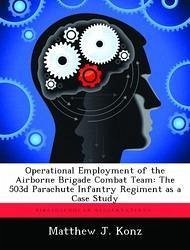Nicht lieferbar

Operational Employment of the Airborne Brigade Combat Team: The 503d Parachute Infantry Regiment as a Case Study
Versandkostenfrei!
Nicht lieferbar
Given the focus on the Brigade Combat Team as the Army's primary combat unit, the limited availability of U.S. Air Force airlift assets, and the U.S. Army history of employing predominantly medium sized airborne units, future airborne operations in support of operational level objectives will likely center around the Airborne Brigade Combat Team (ABCT). The combat airborne operations of the 503d Parachute Infantry Regiment will provide a case study to assess the elements of risk, surprise and the operational context of how the airborne unit contributed to the achievement the operational and st...
Given the focus on the Brigade Combat Team as the Army's primary combat unit, the limited availability of U.S. Air Force airlift assets, and the U.S. Army history of employing predominantly medium sized airborne units, future airborne operations in support of operational level objectives will likely center around the Airborne Brigade Combat Team (ABCT). The combat airborne operations of the 503d Parachute Infantry Regiment will provide a case study to assess the elements of risk, surprise and the operational context of how the airborne unit contributed to the achievement the operational and strategic outcomes. The combat airborne operations discussed are the jump to re-take the island of Corregidor in the Philippines in February 1945, Operation Junction City in February 1967, and the airborne insertion of the 173d Airborne Brigade onto the Bashur airfield in Northern Iraq in March 2003. The intent of this monograph is to provide insights into the possible employment of the current ABCT and how to best use the resources and organization that we have, not necessarily to advocate a radically new airborne organization, propose new equipment, or recommend a new mission for airborne forces.








